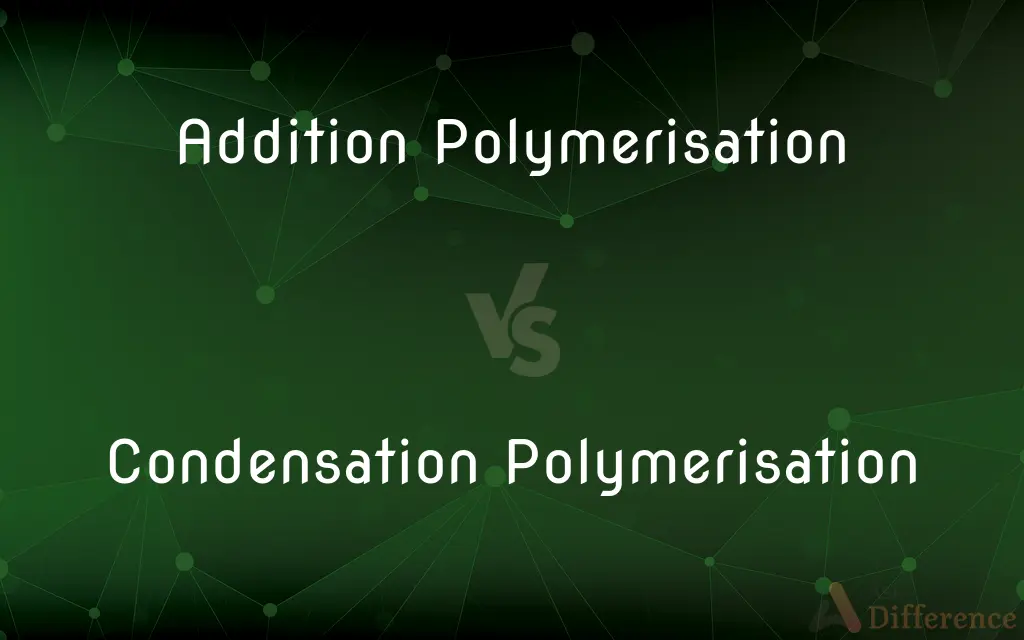Addition Polymerisation vs. Condensation Polymerisation — What's the Difference?
By Tayyaba Rehman — Published on January 7, 2024
Addition Polymerisation involves the polymerization of unsaturated monomers without by-products; Condensation Polymerisation joins monomers with the release of small molecules like water.

Difference Between Addition Polymerisation and Condensation Polymerisation
Table of Contents
ADVERTISEMENT
Key Differences
Addition Polymerisation and Condensation Polymerisation represent two primary mechanisms for forming polymers from monomers. While both result in large molecular structures, their processes and resulting by-products differ significantly.
In Addition Polymerisation, the process involves the polymerization of unsaturated monomers, typically containing double or triple bonds. These bonds break and allow the monomers to join end-to-end without the production of any by-products. Condensation Polymerisation, on the other hand, involves the joining of monomers with the elimination of a small molecule, often water or methanol.
Addition Polymerisation commonly results in the formation of polymers like polyethylene and polypropylene. These polymers are derived from unsaturated hydrocarbons. In contrast, Condensation Polymerisation produces polymers like nylon and polyester, resulting from reactions between functional groups like -OH and -COOH on different monomers.
Polymers produced by Addition Polymerisation often have straightforward and repetitive structures, reflecting the direct joining of monomers. Condensation Polymerisation, however, can result in more complex structures, as the elimination of small molecules can lead to branching and other structural intricacies.
From a commercial standpoint, both Addition Polymerisation and Condensation Polymerisation hold immense value. They cater to the production of a wide variety of materials used daily, from packaging materials to fabrics.
ADVERTISEMENT
Comparison Chart
By-products
None
Small molecules (e.g., water, methanol)
Typical Monomers
Unsaturated hydrocarbons
Monomers with functional groups
Common Resulting Polymers
Polyethylene, polypropylene
Nylon, polyester
Mechanism
Breaking of double/triple bonds
Elimination between functional groups
Structural Complexity
Straightforward, repetitive
Can be more complex, with branching
Compare with Definitions
Addition Polymerisation
The direct joining of monomers with double or triple bonds.
Addition Polymerisation involves breaking the double bond of monomers to form chains.
Condensation Polymerisation
Polymerization involving the elimination of small molecules.
The production of nylon involves Condensation Polymerisation, releasing water.
Addition Polymerisation
Polymerization without the elimination of small molecules.
Unlike Condensation Polymerisation, Addition Polymerisation does not release water.
Condensation Polymerisation
A polymer formation process producing by-products.
When creating polyesters, Condensation Polymerisation releases methanol.
Addition Polymerisation
Formation of polymers without any by-products.
Polypropylene production through Addition Polymerisation does not produce any waste.
Condensation Polymerisation
Formation of polymers from monomers with two distinct functional groups.
The reaction between dicarboxylic acids and diols in Condensation Polymerisation produces polyesters.
Addition Polymerisation
A polymerization process involving unsaturated monomers.
Polyethylene is formed via Addition Polymerisation of ethylene molecules.
Condensation Polymerisation
Process that can lead to complex polymer structures.
The varied structure of some nylons results from branching in Condensation Polymerisation.
Addition Polymerisation
A method producing straightforward and repetitive polymers.
The simple structure of polyvinyl chloride (PVC) is a result of Addition Polymerisation.
Condensation Polymerisation
Joining of monomers via functional group reactions.
Ester linkages in polyester are formed through Condensation Polymerisation.
Common Curiosities
Which polymerization method produces no by-products?
Addition Polymerisation produces polymers without any by-products.
What is a common by-product in Condensation Polymerisation?
Water or methanol is commonly produced in Condensation Polymerisation.
Which method is responsible for producing nylon?
Nylon is produced through Condensation Polymerisation.
Which polymerization process involves functional group reactions?
Condensation Polymerisation involves reactions between functional groups.
Are polyesters formed through Addition or Condensation Polymerisation?
Polyesters are formed through Condensation Polymerisation.
What are the by-products in polyester production?
When producing polyesters, Condensation Polymerisation can release methanol.
Which method involves the use of monomers with two different functional groups?
Condensation Polymerisation often uses monomers with two different functional groups.
How do monomers join in Addition Polymerisation?
In Addition Polymerisation, monomers join directly by breaking double or triple bonds.
What type of monomers are used in Addition Polymerisation?
Unsaturated monomers with double or triple bonds are used in Addition Polymerisation.
How are complex polymer structures achieved?
They can be achieved through Condensation Polymerisation, leading to branching and intricacies.
Can both polymerization methods produce commercially valuable polymers?
Yes, both Addition Polymerisation and Condensation Polymerisation produce polymers valuable for various applications.
Can Condensation Polymerisation result in branching structures?
Yes, Condensation Polymerisation can lead to branching and complex structures.
What is a typical polymer produced by Addition Polymerisation?
Polyethylene is a typical product of Addition Polymerisation.
Is polypropylene a product of Addition or Condensation Polymerisation?
Polypropylene is a product of Addition Polymerisation.
Why doesn't Addition Polymerisation produce water?
Because it involves the direct joining of unsaturated monomers without eliminating any molecules.
Share Your Discovery

Previous Comparison
Demand Deposit vs. Term Deposit
Next Comparison
Convenience Store vs. Grocery StoreAuthor Spotlight
Written by
Tayyaba RehmanTayyaba Rehman is a distinguished writer, currently serving as a primary contributor to askdifference.com. As a researcher in semantics and etymology, Tayyaba's passion for the complexity of languages and their distinctions has found a perfect home on the platform. Tayyaba delves into the intricacies of language, distinguishing between commonly confused words and phrases, thereby providing clarity for readers worldwide.
















































